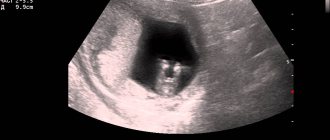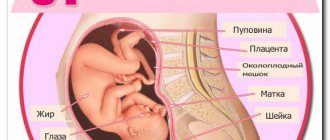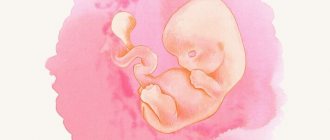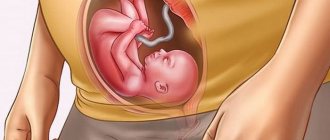Ultrasound is a safe and fairly accurate way to obtain information about the condition of the baby and mother. Ultrasound results at 34 weeks of pregnancy help the doctor obtain data on the condition and size of the uterus, umbilical cord, amniotic fluid and placenta. This information allows us to predict the future passage of the child through the mother’s birth canal.
The examination has no contraindications during pregnancy and does not cause any discomfort to either the baby or the expectant mother.
Why is the study done and to whom is it recommended?
At -34 weeks of pregnancy, a third “scheduled” ultrasound is performed. The doctor receives information that allows him to establish the possibility and features of natural childbirth.
At this stage of pregnancy, it becomes important to determine the following characteristics of the course of pregnancy:
- the location of the fetus in relation to the exit from the uterus;
- placenta parameters;
- presence or absence of umbilical cord entanglement;
- state of amniotic fluid (low or high water).
These are also possible developmental defects of the baby that can be noticed in the later stages of intrauterine development.
Insomnia
The last weeks of pregnancy may be marked by insomnia or disturbing dreams. Some psychologists claim that in this way the body prepares for getting up at night to see the baby.
In order to cope with these phenomena, you need to change your position during sleep, roll over to the other side. Also watch your diet in the evening, reduce the amount of food before bed. The body takes longer to digest heavy foods, which can cause discomfort for the expectant mother and baby.
Mother's condition and how the fetus develops
At 34 weeks of development, the baby's weight increases. There is less room for fetal movement. The baby can only turn smoothly. The skin becomes less “wrinkled” and the germinal fluff disappears. The gastrointestinal tract, cardiovascular, respiratory and musculoskeletal systems are already activated.
The nervous system develops, especially the cerebellum and cerebral cortex. The child actively accumulates subcutaneous fat. At this time, the fetus should already occupy the position in which it will pass through the birth canal, i.e. head down.
A woman's body prepares for childbirth:
- Hormones necessary to soften joints and ligaments are produced in large quantities. This makes it easier for the baby to pass through the birth canal.
- The uterus enlarges and rises higher. The abdomen grows and protrudes forward.
- Painful sensations arise, explained by the size of the baby and the restructuring of the body: pain in the lower back, “pulling” pain in the abdomen, a feeling of contractions of the uterus (irregular “training” contractions).
The expectant mother feels a slowdown in weight gain, but edema may appear during this period.
Feel
There is a gradual softening of the ligaments, so you may feel discomfort in the pubic area. The child may also periodically press on the sciatic nerve. Unfortunately, all that remains is to wait for the birth, then these troubles will pass.
The expectant mother can also feel the baby sink lower and rest its head against the entrance to the pelvis. This will periodically be felt as pressure in the lower abdomen and pubic area. This phenomenon may not bother you, because some babies may lose weight several weeks before the birth itself or directly during labor.
Most likely, not a trace remains of your former grace and lightness. Sometimes even the easiest thing, like getting out of bed, becomes difficult and clumsy. There is no need to complete all household chores in one day; it is important now to take care of your health and well-being.
Enjoy your pregnancy, because it won’t be long before you miss your belly and the movements in it. Perhaps now it seems to you that this is impossible.
You still feel the training contractions, which can last almost a minute. Some women may confuse them with real ones. Unpleasant sensations can be relieved with a warm shower. It is important to observe their systematicity. If the above actions did not help relieve heaviness in the uterus, and if a certain systemic pattern can be identified, consult a doctor.
It is important to remember that lower abdominal descent, diarrhea and the release of mucus plugs may indicate the beginning of the labor process.
In such a situation, you must urgently contact your doctor and tell him about the symptoms.
Real contractions that precede childbirth will manifest themselves in the same way and their frequency will increase. In this case, painful sensations will be similarly displayed on the lower back.
What are they watching?
An ultrasound of the baby during this period involves examining the heart and all internal organs of the child. The doctor checks how developed the baby’s lungs and liver are and performs photometry (measurement of the main bones and growth). The amount and degree of transparency of amniotic fluid is also checked. Using cervicometry, the condition of the uterus and its cervix is checked.
Important! In boys, testicular descent should be checked. This is necessary in order to exclude cryptorchidism in time.
If it is already known that it is a girl, only general indicators are checked: the size and correct position of the fetus, whether the umbilical cord is entwined around the neck.
Recommendations for 34 weeks of pregnancy
There is very little time left before the birth, and so that it does not take you by surprise, we will remind you what you need to do.
- You need to put together the necessary things according to the list that was given to you at the maternity hospital. Also, the necessary documents should always be at hand.
- You have already prepared a place in the apartment for the baby, it may be his separate room or, perhaps, you have decided to place him in your room.
- Don’t forget to photograph your pregnancy, because now your tummy is large, and after giving birth you will look at these photos with great pleasure.
- By the end of this week, you should decide on the choice of maternity hospital, pay attention to whether there is an intensive care unit for children, what types of painless childbirth there are. If you decide that your husband will be present at the birth, is this possible in the chosen maternity hospital? And you should already decide on the gynecologist who will deliver your baby.
- It's time to prepare the muscles of the perineum for childbirth; to do this, do a simple exercise, squeeze and unclench the muscles of the vagina. Also, if you lubricate the perineum with olive or peach oil, its elasticity increases, which prevents ruptures during childbirth.
What can be seen in the photo of the fetus?
During this period of development, the baby is almost completely formed. Its dimensions are almost the same as those it will be at birth.
In the ultrasound photo you can see the baby’s facial features and even facial expressions. The child’s skin is already almost smooth. The fat layer accumulates, so you can see rounded cheeks. Marigolds are clearly visible on the arms and legs.
Differences between boys and girls
At the last planned ultrasound, it is possible to determine the sex of the baby with maximum reliability, if it was not possible to do this earlier. If, even at 33-34 weeks, the position of the fetus remains inconvenient for this, you will have to wait until birth.
Photo of a boy
Photo of a girl
Mother. Changes in the psychological and physical state of the body at 34 weeks
The condition of a woman at the 34th week of pregnancy
The 34th week is filled with many different feelings, sensations and emotions. The expectant mother is increasingly limited in movement, feels heaviness and her own clumsiness. More and more often you want to lie down or rest, and it’s harder to concentrate on current tasks. All this can greatly irritate and upset a woman, but you should not give in to negative thoughts and emotions. There is very little time left before giving birth: from 4 to 8 weeks.
Psychological features of the term
From the 34th week, the woman’s body begins to change the hormonal balance again. Pregnancy is nearing completion, and it’s time for the expectant mother’s body to prepare. These changes often provoke changes in the psychological state of the woman. There may be an increase in touchiness, sensitivity, and a negative attitude towards the environment. All these manifestations are a reaction of the psyche to changes in hormonal levels, so you should not give in to them. The right decision is to look for the positive side in everything, avoid stressful situations, and spend more time doing activities that bring pleasure.
Against the background of changing hormonal levels, increased fear of an upcoming event may occur. Women who are giving birth for the first time or have had complications during childbirth in the past are especially susceptible to this. It is not always possible to suppress emotions; a pregnant woman may become depressed, experience panic attacks, or completely immerse herself in her inner world. Neither of these conditions is desirable.
What to do if it’s hard to overcome fears?
In addition to hormones, the main reason for the appearance of fears is insufficient psychological preparedness for childbirth and motherhood, and fear of complications. These fears need to be addressed carefully, gradually.
First of all, it is necessary to identify the cause that causes unpleasant emotions: fear of pain, complications, lack of preparedness, surprise of childbirth, etc. After this, study the issue in detail, discuss it with a gynecologist, relatives or friends.
If fear is caused by medical aspects of the upcoming birth (pain, complications, unexpected onset of labor), then it is recommended to discuss these issues at the next appointment, without concealing your feelings. It’s a good idea to go to the maternity hospital you have chosen or designated for childbirth and talk about the necessary things and possible options for anesthesia.
It is advisable to discuss fears and worries caused by everyday issues (buying necessary things, preparing the house, organizing discharge and postpartum life, etc.) with loved ones, clearly assigning all the roles and thinking through the details.
To avoid anxiety and prevent panic when labor begins outside the home or maternity hospital, this week you need to collect all the necessary things (the list of permitted items can be checked at the maternity hospital), and carry documents for the maternity hospital with you at all times. Place the necessary items into 3 bags:
- for childbirth;
- for stay in the maternity hospital after childbirth;
- for discharge.
It is recommended to tell your loved ones where everything is, additionally signing each package. When labor begins outside the home, the woman will be able to go straight to the maternity hospital (you should always carry the exchange card with you!), and the necessary things will be brought to her by relatives.
Physical sensations and changes
This week the woman continues to experience discomfort caused by the growth of the uterus. Most of them have already known each other for several weeks and become familiar:
- frequent urination. Many pregnant women complain not only of a constant desire to go to the toilet, but also of the inability to hold urine while sneezing or coughing. This is a normal phenomenon caused by pressure from the enlarged uterus and the weight of the fetus and does not require treatment. Uncontrolled release of urine during sneezing (coughing) occurs due to the production of relaxants that help relax muscles to maintain pregnancy. Some expectant mothers may experience abdominal drooping this week, which will increase pressure on the urinary system; it is recommended to continue using pads without additives to avoid getting into an unpleasant situation;
- inability to take a deep breath, shortness of breath. Every day the fetus gains about 30 g, so it is difficult for a woman at this stage to walk up stairs or cover significant distances. The uterus continues to grow, putting significant pressure on the lungs. Those expectant mothers whose tummy begins to sag this week will be able to feel some relief, others will have to wait a little.
- difficulties with digestion. Heartburn, heaviness in the stomach, difficulty defecating, and flatulence are a consequence of poor nutrition. At this stage, the stomach feels significant pressure, which does not allow it to process large volumes of food at once. As a result, stomach contents may spill into the esophagus (heartburn), causing a feeling of heaviness;
Constipation is a potentially dangerous condition for a pregnant woman. To avoid it, you should eat dried apricots or prunes daily. If you cannot avoid stool retention, you should consult a gynecologist for advice.
- itching The uterus is actively growing, causing the skin of the abdomen to stretch. This leads to a constant desire to scratch it. If the itching is localized only in the abdominal area, this is normal. If the sensation spreads to other parts of the body, additional consultation with a gynecologist is necessary;
- discomfort in the back, problems sleeping. At the 34th week, it is very difficult for a woman to walk due to her enlarged belly. The load on the spinal column is very large, so after a long walk, pregnant women experience aching sensations in the lumbar region. They usually go away gradually with rest, but to fall asleep you need to find a comfortable position. Usually, when the mother moves, the fetus behaves quite quietly, but as soon as she lies down and relaxes, he begins to become active. All this and other reasons affect the expectant mother’s sleep, prolonging the time she falls asleep, periodically waking her up at night.
These sensations are considered normal for a woman’s condition at 34 weeks, but there are symptoms that must be reported to the gynecologist observing the pregnancy:
- burning sensation or pain during urination;
- pain in the kidney area (on the sides of the lower back);
- external changes in urine: it has become dark, contains flakes, cloudy;
- increased or sudden appearance of swelling in the arms, legs, face;
- night leg cramps;
- pulling sensations in the back of the head, headaches;
- appearance or exacerbation of hemorrhoids;
- dizziness with nausea;
- the appearance of dark spots and spider veins on the legs;
- a sharp deterioration in appearance: hair loss, skin laxity, deterioration in the condition of teeth and nails.
These symptoms may indicate the onset of unwanted complications that need to be stopped as quickly as possible. Before visiting a gynecologist, it is advisable to undergo general blood and urine tests.
Explanation: normal indicators
The third screening ultrasound allows you to determine how correctly the child is developing. It allows you to calculate the likelihood of developing various trisomies. The weight of a child during this period of development is approximately 2250 grams. Height – 34 centimeters.
The diagnostician also evaluates the following normal parameters:
- biparietal size (“width” of the head, which is measured from temple to temple) – 86 mm;
- fronto-occipital size – 110 mm;
- head circumference – 317 mm;
- abdominal circumference – 306 mm;
- thigh – 65 mm;
- shin – 60 mm;
- shoulder – 59 mm;
- forearm – 52 mm;
- nasal bones – 12.3 mm.
The size of the orbits is assessed to rule out microphthalmia.
Discharge
The discharge of a pregnant woman is of moderate volume, uniform consistency and milky color. If there is any deviation from the norm, then this should be a cause for concern.
Curdled lumps and flakes released from the genital tract, and the accompanying severe itching, burning and “fishy” smell indicate the development of candidiasis (thrush).
Impurities of pus and an atypical greenish or grayish color indicate an infectious disease caused by a wide range of pathogens - from streptococcus to Trichomonas.
Abundant transparent discharge may indicate a violation of the integrity of the membranes and leakage of amniotic fluid. Oligohydramnios is dangerous for a child, as it increases the risk of infection and the development of various pathologies.
Blood impurities color female discharge scarlet, pink, brown and even black. The presence of blood indicates problems with the placenta, most often its detachment. This organ is fully responsible for the life support of the fetus, therefore, with severe dysfunction of the placenta, there is a high risk of miscarriage and death of the baby.
If uncharacteristic discharge appears, a pregnant woman should under no circumstances delay her visit to the doctor, because the health of the unborn baby depends on it. And if there are significant blood impurities, you should urgently call an ambulance.











